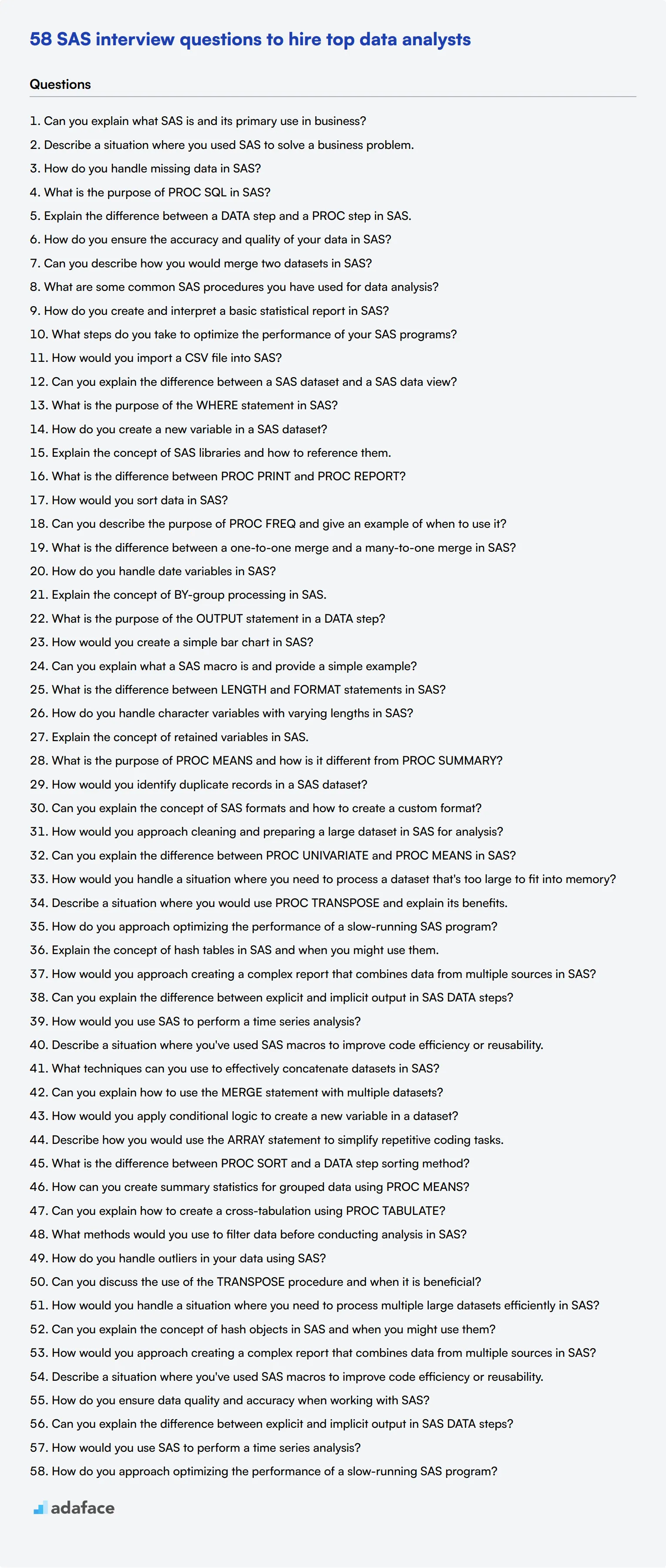Recruiting for SAS positions can be challenging given the range of skills and experiences candidates bring to the table. Finding the right fit is essential, as a strong SAS analyst can significantly impact your business outcomes in data-driven decision-making processes.
This post aims to equip recruiters and hiring managers with a comprehensive list of interview questions tailored to different levels of SAS proficiency. From basic to intermediate questions, and specialized queries on data manipulation and programming techniques, we’ve covered it all.
By leveraging this list, you can streamline your interview process and identify top SAS talent efficiently. Before diving into interviews, consider using our SAS skills test to pre-screen applicants and shortlist the strongest candidates.
Table of contents
10 basic SAS interview questions and answers to assess applicants

To effectively gauge whether candidates possess the fundamental understanding and practical skills needed for SAS roles, consider these 10 basic SAS interview questions. Use these questions during the initial stages of your interview process to identify the right fit for your team.
1. Can you explain what SAS is and its primary use in business?
SAS, or Statistical Analysis System, is a software suite used for advanced analytics, business intelligence, data management, and predictive analytics. It helps businesses in data-driven decision-making by providing tools for data access, transformation, and reporting.
Look for candidates who can clearly articulate SAS's role in handling large datasets and performing complex statistical analyses, showcasing their understanding of its importance in business contexts.
2. Describe a situation where you used SAS to solve a business problem.
A strong candidate should share a specific example where they utilized SAS to address a business challenge. They might talk about data cleaning, analysis, or reporting tasks they performed and how these contributed to solving the problem.
Ideal responses will include details about the problem, the SAS tools they used, the approach they took, and the outcome. This demonstrates their practical experience and problem-solving skills.
3. How do you handle missing data in SAS?
Candidates should explain that handling missing data is crucial in data analysis. They might mention methods such as imputing missing values, excluding incomplete records, or using built-in SAS procedures like PROC MI for multiple imputations.
Look for candidates who understand the impact of missing data on analysis results and can discuss different strategies to address it effectively.
4. What is the purpose of PROC SQL in SAS?
PROC SQL in SAS is used for accessing and manipulating data using SQL language. It allows users to query data, join tables, create new tables, and perform various data transformations within the SAS environment.
An ideal candidate will show familiarity with SQL and its integration within SAS, demonstrating their versatility in using different tools for data analysis.
5. Explain the difference between a DATA step and a PROC step in SAS.
The DATA step is used to create and modify SAS datasets. It involves reading data, transforming it, and writing it to a new dataset. In contrast, the PROC step is used to analyze and process data, generating reports and statistical analyses.
Candidates should highlight their understanding of the distinct roles these steps play in the SAS programming process, showcasing their knowledge of SAS's structure and functionalities.
6. How do you ensure the accuracy and quality of your data in SAS?
Ensuring data accuracy and quality involves several steps, such as data validation, cleaning, and verification. Candidates might mention using PROC MEANS or PROC FREQ to check for anomalies, performing data checks, and implementing validation rules.
Look for candidates who can describe a systematic approach to maintaining data integrity, indicating their attention to detail and commitment to producing reliable results.
7. Can you describe how you would merge two datasets in SAS?
Merging datasets in SAS typically involves using the MERGE statement within a DATA step. Candidates should explain the importance of having common variables to merge on and the steps to align data correctly.
Ideal responses will include awareness of potential issues like duplicate records or mismatches and how to handle them, showing the candidate's practical experience with data merging.
8. What are some common SAS procedures you have used for data analysis?
Common SAS procedures for data analysis include PROC MEANS for descriptive statistics, PROC FREQ for frequency tables, PROC CORR for correlation analysis, and PROC REG for regression analysis. Candidates should mention specific procedures they have used and their applications.
Look for detailed examples of how these procedures were used in real-world scenarios, indicating the candidate’s practical knowledge and analytical skills.
9. How do you create and interpret a basic statistical report in SAS?
Creating a statistical report in SAS involves using procedures like PROC REPORT or PROC TABULATE to generate tables and summaries. Candidates should discuss how they structure their reports, including key metrics and visualizations for clear interpretation.
Ideal candidates will demonstrate their ability to present data findings comprehensively and understand the importance of making reports accessible to non-technical stakeholders.
10. What steps do you take to optimize the performance of your SAS programs?
Optimizing SAS programs can involve techniques like indexing datasets, using efficient data structures, minimizing data reads and writes, and leveraging SAS macros for reusable code. Candidates should mention specific strategies they have used to improve performance.
Look for candidates who can provide examples of performance issues they encountered and how they addressed them, showcasing their problem-solving abilities and technical expertise.
20 SAS interview questions to ask junior analysts
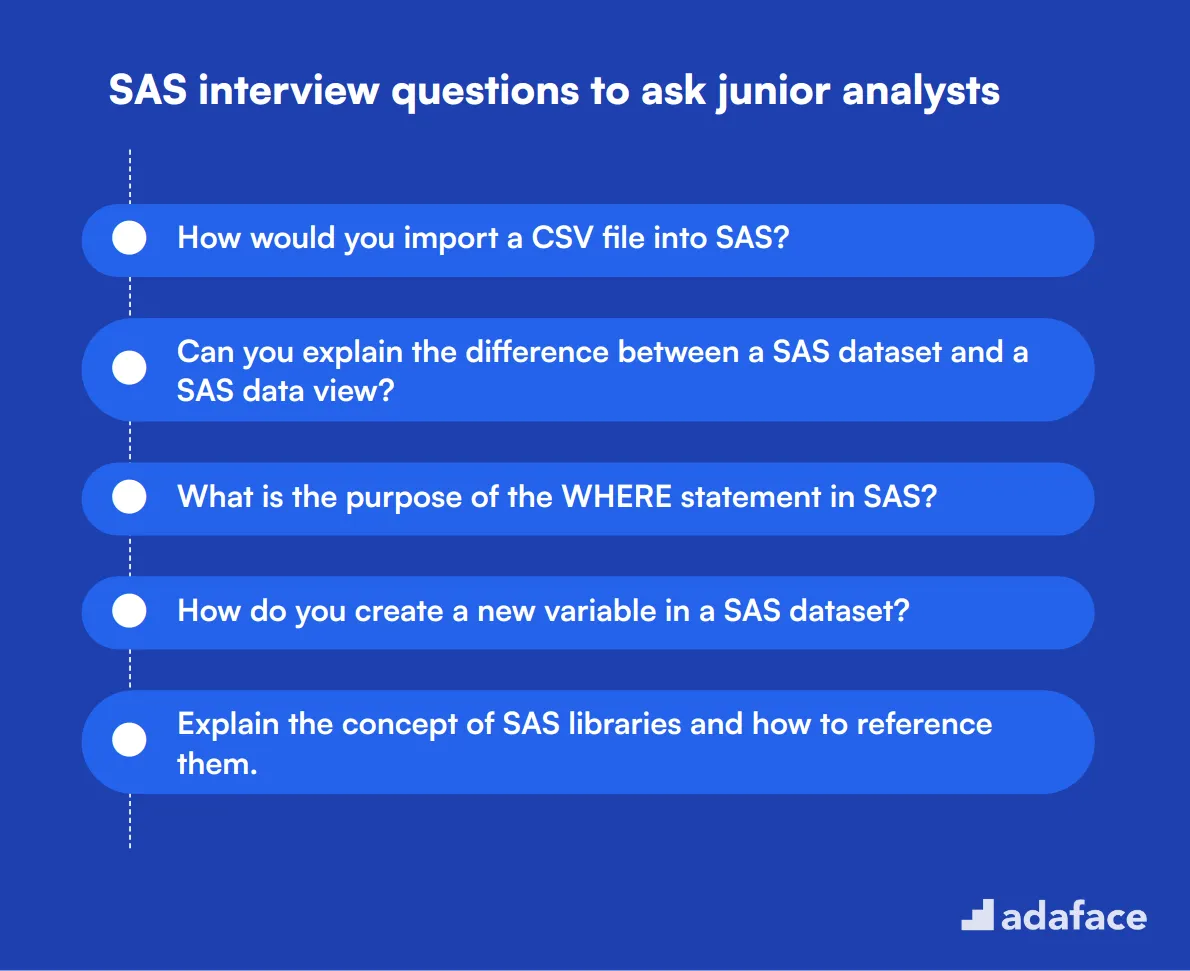
To assess the foundational SAS skills of junior data analysts, use these 20 interview questions. They cover essential concepts and practical applications, helping you identify candidates with a solid grasp of SAS basics and potential for growth.
- How would you import a CSV file into SAS?
- Can you explain the difference between a SAS dataset and a SAS data view?
- What is the purpose of the WHERE statement in SAS?
- How do you create a new variable in a SAS dataset?
- Explain the concept of SAS libraries and how to reference them.
- What is the difference between PROC PRINT and PROC REPORT?
- How would you sort data in SAS?
- Can you describe the purpose of PROC FREQ and give an example of when to use it?
- What is the difference between a one-to-one merge and a many-to-one merge in SAS?
- How do you handle date variables in SAS?
- Explain the concept of BY-group processing in SAS.
- What is the purpose of the OUTPUT statement in a DATA step?
- How would you create a simple bar chart in SAS?
- Can you explain what a SAS macro is and provide a simple example?
- What is the difference between LENGTH and FORMAT statements in SAS?
- How do you handle character variables with varying lengths in SAS?
- Explain the concept of retained variables in SAS.
- What is the purpose of PROC MEANS and how is it different from PROC SUMMARY?
- How would you identify duplicate records in a SAS dataset?
- Can you explain the concept of SAS formats and how to create a custom format?
10 intermediate SAS interview questions and answers to ask mid-tier analysts
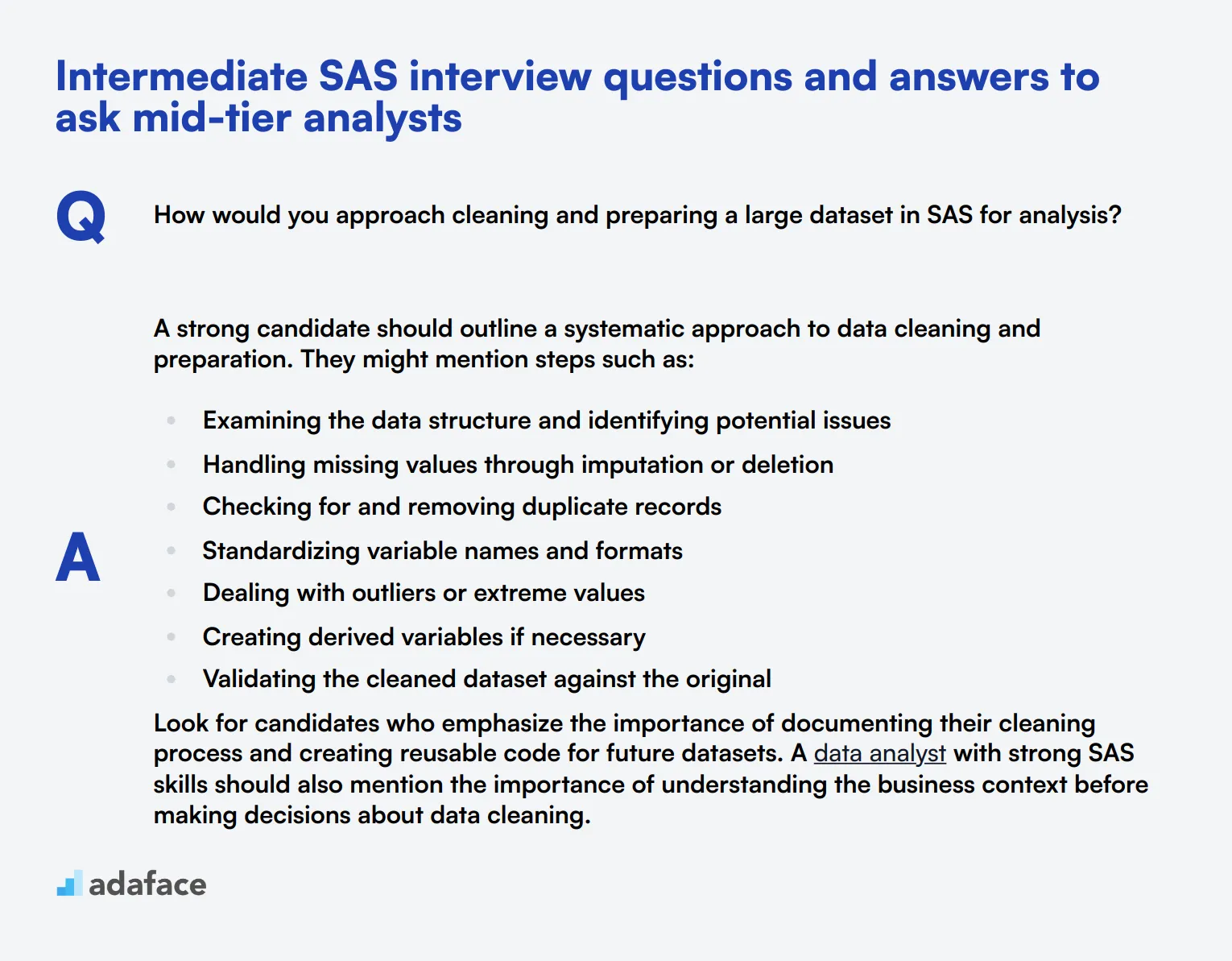
Ready to level up your SAS interview game? These 10 intermediate questions are perfect for assessing mid-tier analysts. They'll help you gauge a candidate's practical knowledge and problem-solving skills without diving too deep into the technical weeds. Use these questions to spark insightful discussions and uncover how well your candidates can apply SAS in real-world scenarios.
1. How would you approach cleaning and preparing a large dataset in SAS for analysis?
A strong candidate should outline a systematic approach to data cleaning and preparation. They might mention steps such as:
- Examining the data structure and identifying potential issues
- Handling missing values through imputation or deletion
- Checking for and removing duplicate records
- Standardizing variable names and formats
- Dealing with outliers or extreme values
- Creating derived variables if necessary
- Validating the cleaned dataset against the original
Look for candidates who emphasize the importance of documenting their cleaning process and creating reusable code for future datasets. A data analyst with strong SAS skills should also mention the importance of understanding the business context before making decisions about data cleaning.
2. Can you explain the difference between PROC UNIVARIATE and PROC MEANS in SAS?
PROC UNIVARIATE and PROC MEANS are both used for descriptive statistics in SAS, but they serve different purposes:
- PROC MEANS is primarily used for calculating basic descriptive statistics like mean, standard deviation, minimum, and maximum. It's efficient for large datasets and can easily compute statistics by group.
- PROC UNIVARIATE provides a more comprehensive set of descriptive statistics, including percentiles, mode, and measures of shape (skewness and kurtosis). It also generates various plots for visual analysis.
A strong candidate should be able to explain when they would choose one over the other. For instance, they might use PROC MEANS for quick summary statistics in data exploration, while opting for PROC UNIVARIATE when a deeper understanding of the data distribution is needed.
3. How would you handle a situation where you need to process a dataset that's too large to fit into memory?
An experienced SAS analyst should be familiar with techniques for handling large datasets. They might suggest:
- Using SAS's built-in ability to process data in chunks or 'by group'
- Employing the BUFSIZE and BUFNO options to optimize I/O operations
- Utilizing indexing to speed up data access
- Considering SAS compression techniques to reduce dataset size
- Using SQL pass-through to push processing to the database level when possible
Look for candidates who demonstrate an understanding of SAS's memory management and can explain the trade-offs between processing speed and memory usage. They should also mention the importance of testing their approach with a subset of data before processing the entire dataset.
4. Describe a situation where you would use PROC TRANSPOSE and explain its benefits.
PROC TRANSPOSE is used to restructure data from long to wide format or vice versa. A good answer might include:
- Preparing data for certain types of analyses that require wide format (e.g., repeated measures ANOVA)
- Creating summary reports where each row represents a unique ID and columns represent different variables
- Reshaping data for visualization purposes, especially when creating charts or graphs
An ideal candidate should be able to provide a specific example from their experience, explaining how PROC TRANSPOSE helped solve a real-world problem. They should also mention potential challenges, such as handling missing values during transposition or dealing with large datasets.
5. How do you approach optimizing the performance of a slow-running SAS program?
A skilled SAS analyst should have a systematic approach to performance optimization. They might mention:
- Analyzing the log file to identify bottlenecks or inefficient operations
- Using PROC SQL instead of DATA steps where appropriate
- Indexing frequently used variables in large datasets
- Employing BY-group processing to reduce I/O operations
- Utilizing SAS options like COMPRESS and REUSE to manage memory usage
- Considering hardware solutions like SAS Grid for parallel processing
Look for candidates who emphasize the importance of benchmarking before and after optimization attempts. They should also mention the need to balance performance improvements with code readability and maintainability. A data engineer with SAS experience might also discuss integrating SAS with other tools for enhanced performance.
6. Explain the concept of hash tables in SAS and when you might use them.
Hash tables in SAS are in-memory lookup tables that can significantly speed up data processing, especially for tasks involving frequent lookups or merges. A good answer should cover:
- How hash tables store data as key-value pairs for quick retrieval
- The benefits of using hash tables, such as faster processing compared to traditional merge or lookup methods
- Situations where hash tables are particularly useful, like real-time data processing or working with large datasets
Look for candidates who can provide specific examples of how they've used hash tables to solve performance issues. They should also be aware of the trade-offs, such as increased memory usage, and be able to discuss when hash tables might not be the best solution.
7. How would you approach creating a complex report that combines data from multiple sources in SAS?
Creating complex reports often requires a mix of SAS skills. A strong candidate might outline a process like:
- Understanding the report requirements and identifying all necessary data sources
- Cleaning and preparing each dataset, ensuring consistency in variable names and formats
- Merging or joining datasets using appropriate techniques (PROC SQL, DATA step merges, or hash tables)
- Creating calculated fields or summary statistics as needed
- Using PROC REPORT or ODS to format the output according to specifications
- Implementing error checking and data validation throughout the process
Look for candidates who emphasize the importance of modularity in their code, making it easier to troubleshoot and maintain. They should also mention considerations for report performance, especially when dealing with large datasets or frequent refreshes. A candidate with business intelligence experience might also discuss integrating SAS outputs with other reporting tools.
8. Can you explain the difference between explicit and implicit output in SAS DATA steps?
Understanding the difference between explicit and implicit output is crucial for efficient SAS programming. A good answer should cover:
- Implicit output: SAS automatically writes an observation to the output dataset at the end of each DATA step iteration, unless told otherwise.
- Explicit output: The programmer uses OUTPUT statements to control when and what data is written to the output dataset.
Look for candidates who can explain scenarios where explicit output is preferable, such as creating multiple observations from a single input record or selectively outputting data based on conditions. They should also be able to discuss potential pitfalls, like unintentionally creating duplicate records with explicit output.
9. How would you use SAS to perform a time series analysis?
Time series analysis in SAS involves several steps and procedures. A strong candidate might outline an approach like:
- Preparing the data, ensuring it's in the correct format with a time variable
- Using PROC TIMESERIES to decompose the series into trend, seasonal, and irregular components
- Employing PROC ARIMA for modeling and forecasting
- Utilizing PROC FORECAST for simpler forecasting tasks
- Applying PROC EXPAND for data transformations like lagging or leading variables
Look for candidates who mention the importance of visualizing the data using PROC SGPLOT or other graphing procedures to identify patterns. They should also discuss methods for handling seasonality and trends, as well as the importance of checking model assumptions and diagnostics. A candidate with a strong data science background might also mention more advanced techniques like ARIMAX models for incorporating external variables.
10. Describe a situation where you've used SAS macros to improve code efficiency or reusability.
SAS macros are powerful tools for creating reusable and dynamic code. A good answer might include:
- Using macros to generate repetitive code, such as creating similar reports for different departments
- Developing parameter-driven macros that can adapt to different datasets or analysis requirements
- Creating utility macros for common tasks like data validation or error handling
- Using macro variables to make code more flexible and easier to maintain
Look for candidates who can provide specific examples from their experience, explaining how macros solved a particular problem or improved workflow efficiency. They should also be able to discuss potential drawbacks of overusing macros, such as reduced readability, and strategies for documenting macro code effectively.
10 SAS questions related to data manipulation
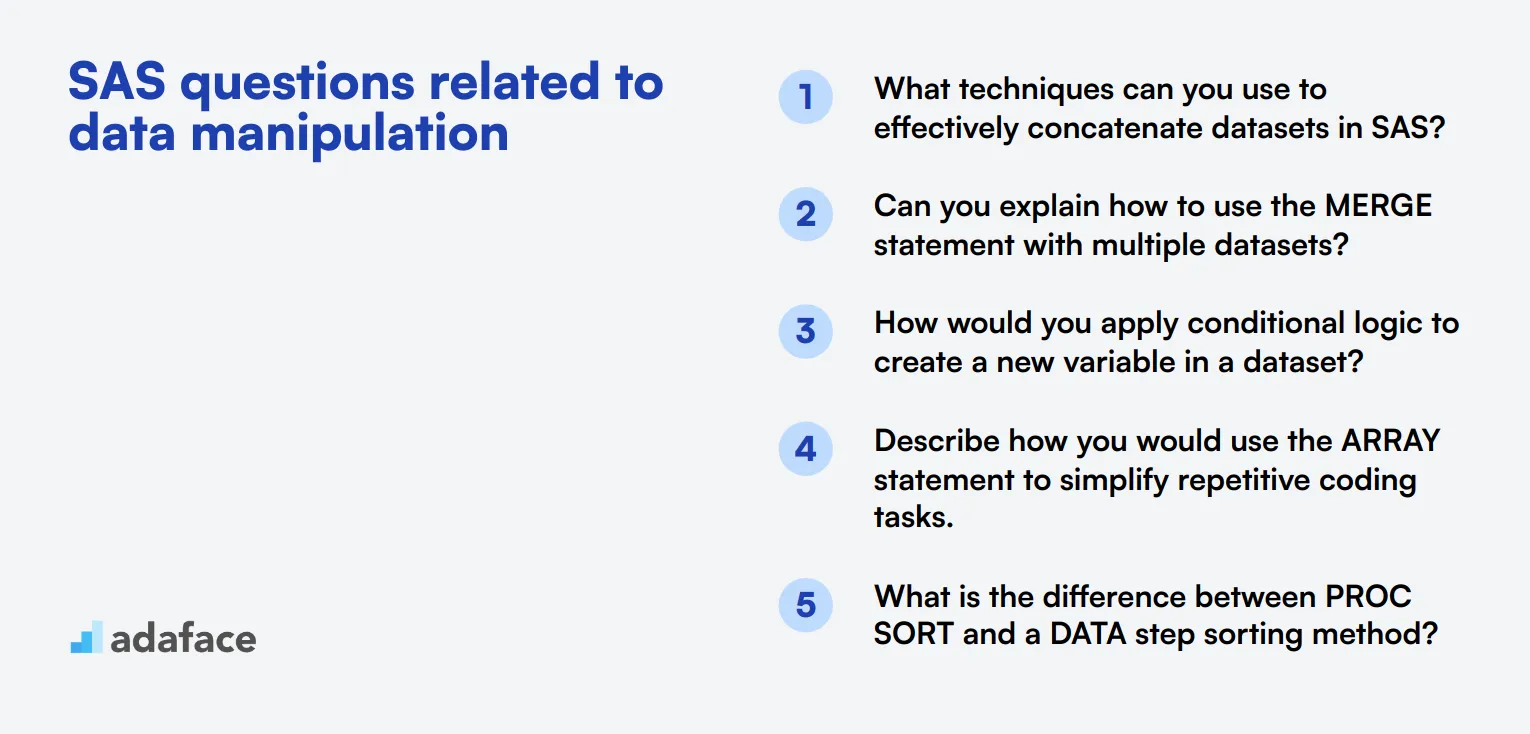
To evaluate candidates' skills in data manipulation using SAS, utilize this list of targeted interview questions. These queries are designed to reveal how well applicants can manage, transform, and analyze data effectively, ensuring they align with your team's needs. For more insights, check out our data analyst job description.
- What techniques can you use to effectively concatenate datasets in SAS?
- Can you explain how to use the MERGE statement with multiple datasets?
- How would you apply conditional logic to create a new variable in a dataset?
- Describe how you would use the ARRAY statement to simplify repetitive coding tasks.
- What is the difference between PROC SORT and a DATA step sorting method?
- How can you create summary statistics for grouped data using PROC MEANS?
- Can you explain how to create a cross-tabulation using PROC TABULATE?
- What methods would you use to filter data before conducting analysis in SAS?
- How do you handle outliers in your data using SAS?
- Can you discuss the use of the TRANSPOSE procedure and when it is beneficial?
8 SAS interview questions and answers related to programming techniques
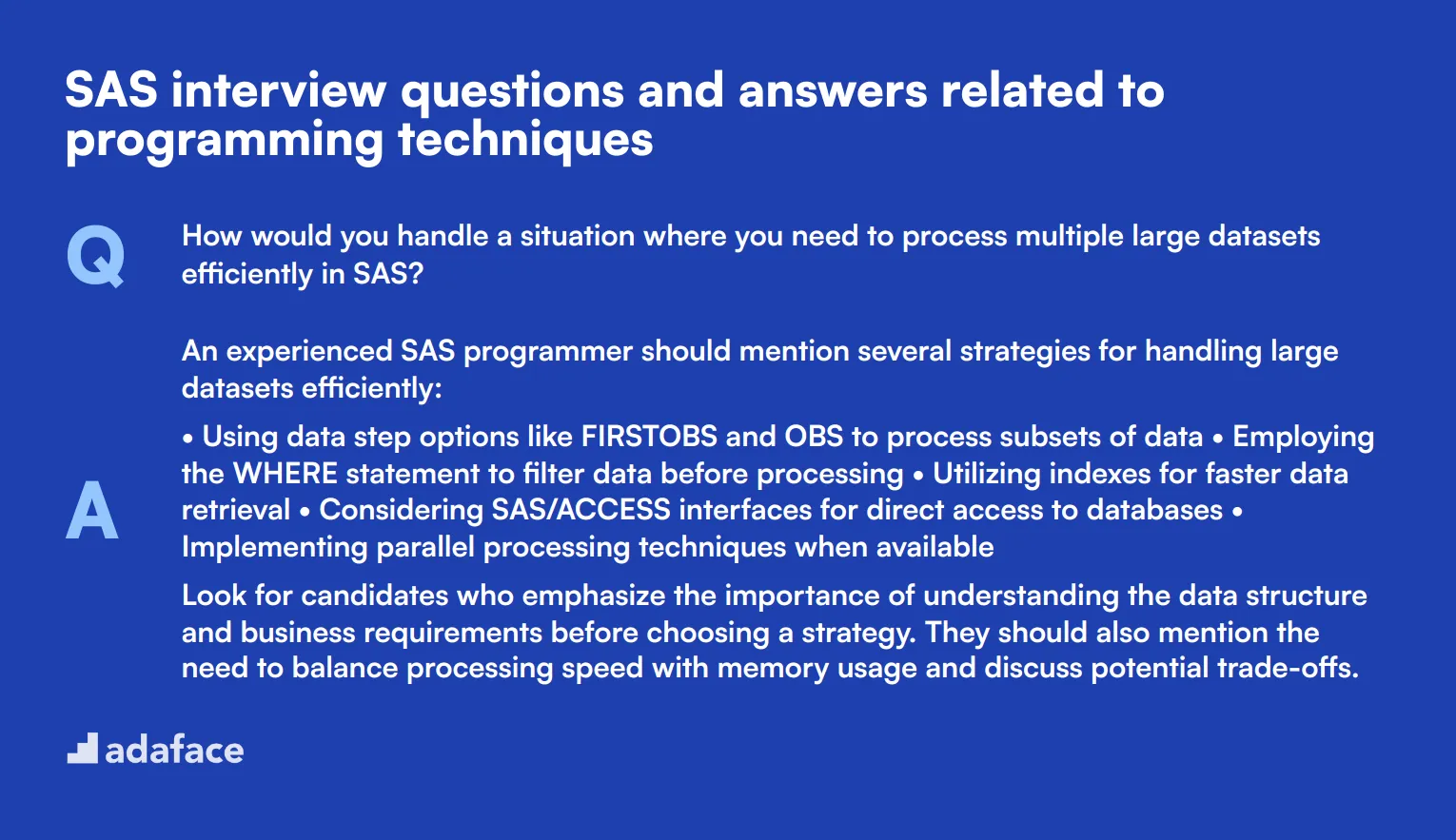
Ready to dive into the nitty-gritty of SAS programming techniques? These 8 interview questions will help you gauge candidates' practical knowledge and problem-solving skills. Use them to spark discussions about real-world scenarios and uncover how applicants approach complex data challenges. Remember, the best data analysts aren't just code wizards; they're creative problem solvers too!
1. How would you handle a situation where you need to process multiple large datasets efficiently in SAS?
An experienced SAS programmer should mention several strategies for handling large datasets efficiently:
• Using data step options like FIRSTOBS and OBS to process subsets of data • Employing the WHERE statement to filter data before processing • Utilizing indexes for faster data retrieval • Considering SAS/ACCESS interfaces for direct access to databases • Implementing parallel processing techniques when available
Look for candidates who emphasize the importance of understanding the data structure and business requirements before choosing a strategy. They should also mention the need to balance processing speed with memory usage and discuss potential trade-offs.
2. Can you explain the concept of hash objects in SAS and when you might use them?
Hash objects in SAS are in-memory lookup tables that allow for quick data retrieval and manipulation. They're particularly useful when:
• Performing table lookups on large datasets • Needing to search for multiple keys simultaneously • Dealing with data that doesn't fit a typical BY-group processing scenario • Requiring faster processing than traditional merge or join operations
A strong candidate should be able to provide a simple example of hash object usage and discuss potential performance benefits. Look for answers that also mention limitations, such as increased memory usage, as this shows a balanced understanding of the tool.
3. How would you approach creating a complex report that combines data from multiple sources in SAS?
A comprehensive answer should outline a step-by-step approach:
- Analyze the report requirements and identify all necessary data sources
- Determine the most efficient way to combine the data (e.g., PROC SQL joins, DATA step merges)
- Clean and standardize the data from different sources
- Use appropriate SAS procedures for summarization and analysis (e.g., PROC SUMMARY, PROC MEANS)
- Employ ODS (Output Delivery System) for formatting and presenting the results
- Implement error handling and data validation checks
Ideal candidates will emphasize the importance of understanding the business context and end-user needs. They should also mention the potential need for iterative development and stakeholder feedback throughout the process.
4. Describe a situation where you've used SAS macros to improve code efficiency or reusability.
A strong answer might describe a scenario like this:
"I once worked on a project that required generating similar reports for multiple departments. Instead of writing separate code for each report, I created a macro that took department name as a parameter. The macro handled data extraction, processing, and report generation. This not only reduced the code length by 70% but also made updates and maintenance much easier."
Look for candidates who can explain the benefits of their macro implementation, such as reduced code duplication, easier maintenance, and improved consistency across reports. They should also be able to discuss potential drawbacks, like increased complexity for novice users, showing a nuanced understanding of macro usage.
5. How do you ensure data quality and accuracy when working with SAS?
A comprehensive answer should cover multiple aspects of data quality assurance:
• Implementing data validation checks in DATA steps • Using PROC FREQ and PROC MEANS for data profiling • Employing PROC COMPARE to verify data transformations • Implementing error handling and logging mechanisms • Conducting regular data audits and reconciliations • Collaborating with domain experts to validate business rules
Strong candidates will emphasize the importance of understanding the data sources and business context. They should also mention the need for documentation and version control in the data quality process. Look for answers that highlight proactive approaches to identifying and addressing data issues.
6. Can you explain the difference between explicit and implicit output in SAS DATA steps?
A clear explanation should cover the following points:
• Implicit output occurs automatically at the end of each DATA step iteration unless suppressed • Explicit output is controlled by the programmer using OUTPUT statements • Implicit output creates one observation per DATA step iteration • Explicit output allows for creating multiple observations or selectively outputting observations
Look for candidates who can provide simple examples of when to use each type of output. They should also be able to discuss the implications of using explicit output, such as the need to manage the automatic end-of-step output and potential performance considerations for large datasets.
7. How would you use SAS to perform a time series analysis?
A comprehensive answer should outline the key steps and SAS procedures involved:
- Data preparation: Use PROC SORT to order data chronologically
- Exploratory analysis: Employ PROC SGPLOT or PROC GPLOT for visual inspection
- Decomposition: Utilize PROC TIMESERIES or PROC UCM for trend and seasonality analysis
- Stationarity testing: Apply PROC ARIMA with the IDENTIFY statement
- Model fitting: Use PROC ARIMA for ARIMA models or PROC UCM for state space models
- Forecasting: Generate predictions using the fitted model
- Model diagnostics: Analyze residuals and fit statistics
Strong candidates will mention the importance of understanding the underlying business context and choosing appropriate techniques based on the data characteristics. Look for answers that also discuss potential challenges in time series analysis, such as handling missing data or dealing with outliers.
8. How do you approach optimizing the performance of a slow-running SAS program?
An experienced SAS programmer should outline a systematic approach to performance optimization:
- Identify bottlenecks using SAS logs and performance profiling tools
- Analyze data access patterns and optimize I/O operations
- Review and optimize DATA step operations (e.g., using WHERE instead of IF statements)
- Evaluate and improve SQL query performance
- Consider using indexes for large datasets
- Implement parallel processing techniques where applicable
- Optimize memory usage through appropriate data step options
Look for candidates who emphasize the importance of benchmarking before and after optimizations. They should also mention the need to balance performance improvements with code readability and maintainability. Strong answers will include examples of specific optimization techniques they've successfully applied in the past.
Which SAS skills should you evaluate during the interview phase?
You can't assess every aspect of a candidate in a single interview. However, for SAS-related roles, there are some core skills you should focus on evaluating to ensure the candidate is a well-rounded fit for your team.

Data Manipulation
Data manipulation is a fundamental SAS skill. It involves transforming and cleaning data to prepare it for analysis. This is crucial as raw data often needs significant preprocessing before any meaningful analysis can be performed.
You can use an assessment test that asks relevant MCQs to filter out this skill. Consider using the SAS test to evaluate candidates' data manipulation capabilities.
Ask targeted interview questions specifically aimed at judging their data manipulation skills.
Can you describe a situation where you had to clean and transform a large dataset? What tools and methods did you use?
Look for responses that demonstrate a clear understanding of data cleaning techniques, including handling missing values, outliers, and data transformations. The candidate should also mention specific SAS procedures and functions used.
Statistical Analysis
Statistical analysis is at the core of SAS applications. Being adept at statistical methods allows a candidate to derive insights from data and make data-driven decisions. This skill is especially important for roles involving data analytics and research.
Filter out this skill by using an assessment test with relevant MCQs. The SAS test includes questions that gauge statistical analysis capabilities.
Ask interview questions that directly assess their statistical analysis skills.
Could you explain how you would perform a linear regression analysis in SAS?
Expect the candidate to outline the steps for performing linear regression, including data preparation, running the PROC REG procedure, and interpreting the output. This shows their practical knowledge and application of statistical methods in SAS.
SAS Programming Techniques
Understanding SAS programming techniques is essential for writing efficient and effective code. SAS programming includes writing scripts, creating macros, and employing various procedures to manipulate and analyze data.
You can use an assessment test with relevant MCQs to evaluate this skill. The SAS test covers various programming techniques.
Ask questions during the interview to assess their familiarity with SAS programming techniques.
How would you use a SAS macro to automate repetitive tasks?
Look for answers that detail the process of creating and using macros, including defining macro variables and functions. The candidate should also explain the benefits of automating tasks using macros in SAS.
3 Tips for Effectively Using SAS Interview Questions
As you prepare to implement what you've learned, here are some valuable tips to enhance your interview process with SAS questions.
1. Incorporate Skills Tests Prior to Interviews
Using skills tests before interviews allows you to gauge a candidate's technical abilities and ensure they meet baseline requirements. For SAS roles, consider using the SAS Test to evaluate specific skill sets relevant to the position.
By assessing candidates through structured testing, you can identify those with the right skills and reduce the time spent on candidates who may not fit the role. This approach helps in streamlining the interview process, allowing you to focus on the best candidates for further evaluation.
Implementing skills tests not only saves time but also enhances the quality of your hiring decisions by providing objective data on candidate capabilities. This opens the door to the next essential tip.
2. Curate a Targeted Set of Interview Questions
Time is often limited during interviews, so selecting a targeted set of questions is key to effectively evaluating candidates. Focusing on a few relevant questions ensures you capture essential aspects of the candidate’s skills and fit for the role.
In addition to SAS-related inquiries, consider integrating other relevant questions, such as those assessing soft skills like communication or cultural fit. You may find useful resources like behavioral interview questions or communication skills interview questions that can complement your SAS questions.
Limiting your questions while ensuring they are impactful will enhance the candidate evaluation process, providing a clearer picture of their capabilities and fit.
3. Ask Insightful Follow-Up Questions
Merely asking interview questions won't suffice. It’s essential to incorporate follow-up questions to gain deeper insights into a candidate's experience and understanding, helping to uncover any discrepancies or surface-level responses.
For instance, if a candidate states they have experience with SAS data manipulation, you might ask, 'Can you provide an example where you had to manipulate a complex dataset?' This follow-up allows you to evaluate their depth of knowledge and practical application, revealing how well they can navigate real-world challenges.
Use SAS interview questions and skills tests to hire talented data analysts
If you're looking to hire someone with SAS skills, it's important to ensure they possess the necessary expertise. The most accurate way to do this is by using skill tests. Consider using the SAS Test or the Data Science Test from our library.
Once you have the test results, you can shortlist the best applicants and call them for interviews. To take the next step, sign up at Adaface or explore our online assessment platform for more details.
SAS Test
Download SAS interview questions template in multiple formats
SAS Interview Questions FAQs
Ask a mix of basic, intermediate, and advanced questions covering data manipulation, programming techniques, and analytical skills.
Use a combination of technical questions, practical scenarios, and coding exercises to assess their SAS knowledge and problem-solving abilities.
Yes, tailor your questions based on the candidate's experience level, with more complex topics for senior roles.
Incorporating practical tasks can provide valuable insights into a candidate's SAS skills and approach to real-world problems.

40 min skill tests.
No trick questions.
Accurate shortlisting.
We make it easy for you to find the best candidates in your pipeline with a 40 min skills test.
Try for freeRelated posts
Free resources




